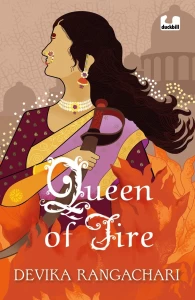The following extended review essay was written by Ritwika Roy.
At first glance, the three books in Devika Rangachari’s Queen Series – Queen of Ice (2014), Queen of Earth (2020) and Queen of Fire (2021) – might seem like a relative of the hit Korean drama Queen of Tears. In Queen of Tears, Hong Haein, like the three queens of Rangachari’s series, is heir to a conglomerate, facing a life-changing situation and a fight to survive. Unlike her, however, Rangachari’s queens are historical figures from the Indian subcontinent; they were not designated heirs to their fathers’ kingdoms; they faced sexism, ableism, imperialism, and erasure, but rose to legendary status, nonetheless.

In Queen of Ice, the 10th–century Didda of Kashmir lives by the motto that she is “destined for greatness” (22) to cope with the deformed foot that sees her shunned by her father and exchanged for land in marriage to the King of Kashmir. As Queen consort, then regent, then regnant, Didda is ruthless and manipulative in her reign and not above assassinating her own grandchild to secure her reign, as a woman in a patriarchal kingdom navigating ugly court politics and assassination attempts. Rangachari’s adoption of a dual narrative lens gives an interior and exterior look at Didda and her motivations and fears. Through Didda’s own first-person account and that of Didda by her faithful handmaiden Valga, Rangachari fleshes out a woman beyond the historical records, whose ambition to forge her own identity subservient to none took Kashmir to greatness.

Rangachari uses the first-person narrative technique again in Queen of Earth as well, this time to bring to life 9th–century Prithvimahadevi or Tribhuvanamahadevi II of the Bhaumakara kingdom of Toshali, in present-day Odisha. With little historical detail available about Prithvi – a result of deliberate erasure by her successors – Rangachari imagines what the woman must have been like and the circumstances of her reign and supposed abdication. Rangachari looks into the political landscape of 9th-century Eastern India to reconstruct Prithvi’s life as a puppet queen, desperate to free herself from her cruel father’s ambitions to conquer and annex Toshali to his own larger kingdom of the Somvamshi dynasty. A pawn in her father’s games, she is a caged bird, whose only deemed purpose is to fulfil her father and brother’s greed, and Rangachari deftly weaves poignance, longing, pathos, and fear into Prithvi’s being. Unlike that of Didda or Lakshmibai, Prithvi’s story does not carry an ending in this novel, which is in keeping with the lack of closure present in the historical queen’s story.

Rani Lakshmibai’s story in Queen of Fire, however, begins with the ending looming. One of the greatest leaders of The First War of Indian Independence in 1857 from British rule, the Rani of Jhansi’s tale is well-recorded, studied in schools, and venerated to the point of glorification. We know what the ending is, and it is what happens before the ending that Rangachari dwells on, this time as a third-person narrator homed in on the protagonist. Rangachari’s Lakshmibai is not the fearless, idolized leader of an army who donned male clothing to fight against colonial rule that she has been immortalized as, but a recently widowed woman who desperately tries to keep the throne of Jhansi secure for her adopted son, Damodar. Lord Dalhousie’s Doctrine of Lapse, threatening to swallow up Jhansi within the larger East India Company ruled India as it had other small kingdoms, forces her to become a martial queen, as Rangachari highlights. The woman in this novel is simultaneously larger than life and human, a goddess and a mother, and this is well-illustrated through Rangachari’s usage of historical dates, which at once bring together public history and private lived experience. It is one thing to say that the Rani and Damodar fled Jhansi on 4th April 1858, but what had they felt before and during the experience? What anxieties, fears, and hopes had plagued Lakshmibai and her son? It is this history that Rangachari excavates, as she does for all three Queens in the series.
The private stories and the felt emotions are prioritised in Rangachari’s un-erasure of women’s histories, inspired by her own doctoral research as a feminist historian. Her poetic evocations of the intimate lives of these women bring them out of obscurity that male-dominated narratives push them into and address the double standards with which male and female rulers are judged, as she tells Vidya Mani. Her ethos is quietly summed up in Queen of Ice: “They do not know what to make of a female king, a woman who transgresses the norms to wield power, a woman who does not hide her gender in male garb but flaunts her beauty and femininity like a weapon (150).”
Queen of Ice won the Neev Book Award 2018 for Young Adult Fiction and has been optioned by Netflix for a series. It was also shortlisted for the Sathiya Akademi’s Bal Sahitya Puraskar in 2019 and featured on the White Raven List by the International Youth Library in 2015. Queen of Earth has featured on the Parag Honours List for 2021 and was shortlisted for the Neev Book Award 2021. Queen of Fire has featured on the Honours List for 2022. These are honours the novels deserve and they firmly establish Rangachari as one of the foremost authors of historical YA fiction in India. Her academic training gives her a particular sensitivity to championing these forgotten women – and I include Lakshmibai here whose identity as a woman is overshadowed by her legacy as a hero in popular culture – and one can only hope that more historical Queens are lying in wait for Rangachari to find and excavate their humanity under history.

About Devika Rangachari: Dr. Devika Rangachari is an award-winning writer and historian whose debut non-fiction for adults, The Mauryas, was recently published by Simon & Schuster India. Among her books for young adults are Queen of Ice (now part of the Penguin Classics series and optioned for a movie), Queen of Earth and Queen of Fire.
Queen of Ice (2014), Queen of Earth (2020) and Queen of Fire (2021)
Written by Devika Rangachari
Duckbill, Penguin Random House
ISBNs: Ice: 9789383331185, Earth: 9780143451754, Fire: 9780143453222
Awards: Queen of Ice won the Neev Book Award 2018 for Young Adult Fiction, was shortlisted for the Sathiya Akademi’s Bal Sahitya Puraskar in 2019, and featured on the White Raven List by the International Youth Library in 2015. Queen of Earth has featured on the Parag Honours List for 2021 and was shortlisted for the Neev Book Award 2021. Queen of Fire has featured on the Honours List for 2022.

Ritwika Roy (she/her) is a PhD Candidate and former Senior Research Fellow at the Department of English, Jadavpur University, India; and co-founder of the Association for Children’s Literature in South Asia.
—

GLLI’s 2024 International YA Literature Month has been curated by Dr Emily Corbett. She is a lecturer in children’s and young adult literature at Goldsmiths, University of London, where she leads the MA Children’s Literature: Theoretical Approaches to Children’s and Young Adult Literature programme. Her research focuses on the growth and development of YA from literary, publishing, and cultural perspectives. She is also General Editor of The International Journal of Young Adult Literature and was founding Vice President of the YA Studies Association. Her monograph, In Transition: Young Adult Literature and Transgender Representation (2024), is forthcoming with the University Press of Mississippi in June. You can find her contact details on her institutional website and connect with her on Twitter and Instagram via @DrEmilyCorbett.
Opinions expressed in posts on this site are the individual author’s and are not indicative of the views of Global Literature in Libraries Initiative.

One thought on “#IntlYALitMonth Review Essay: The Queen Series”